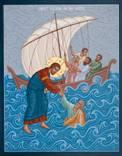Walking on Water and Calming the Storm
WALKING ON WATER AND CALMING OF STORM
Objectives:
 Students should be able to tell the story of the two miracles in their own words.
Students should be able to tell the story of the two miracles in their own words.- Students should be able to identify Peter as the disciple who walked on water.
Possible Lesson Plan:
- Open with prayer.
- Scripture References: Luke 8: 22-25, John 6: 16-21, Matthew 14:24-33, Mark 4: 36-41, 6:47-52. We have here 2 separate miracles, both involving boat trips. Again, make 2 columns on your board: “Calming the storm” and “Walking on Water.” Where were the disciples? What was Jesus doing in each case? What was the weather like? How did the disciples feel? How did Jesus respond? Who came walking across the water? Who wanted to walk with Jesus? What happened when Peter looked down? How did Jesus respond?
- Discussion questions: What do we enjoy about good weather? What are some consequences of bad weather? How do we feel in a storm? Has anyone ever seen a truly bad storm? Can we control the weather today with science? What was Jesus trying to teach his disciples when He stilled the storm? St. Gregory Nazianzus tells us that the ship was carrying Jesus, the God-man, the man weary and asleep but as God stilling the storm. In the stilling of the storm, the prophecies of Habakkuk and Nahum in the Old Testament were fulfilled.
Do we face “stormy times” that have nothing to do with weather? Brainstorm and list some: moving away, failing in school, divorce, arguing with my parents, death getting sick…Now separate these into 2 groups – ones I can change and ones I cannot change. What can we do about the things we cannot change? (prayer) The disciples called on Jesus and He was there. So can we. In fact, in Liturgy we pray in the litany for many things we cannot control. Can you name some? (seasonable weather, peaceful times, travelers by land…, sick and suffering, captives, etc.) Write your own litany using the “stormy times” list for your own prayers. St. Augustine reminds us in these times to awaken the sleeping Christ in us since He is always present with us, ready to help.
- Is it easy to trust God? Peter leaped out of the boat, full of faith – certainly an unusual act, and one none of the others even attempted. While he kept his eyes on Jesus, what happened? His first state of faith and hope were wondrous but then his soul became filled with human reasoning and human methods of preserving his life. When he looked at the water and thought about the danger, what happened? Look again at “Seek ye first the kingdom of God.” Where should our focus be? Is it?
- Play a learning game: Bible Relay. Divide into 2 teams. Line the teams up at one end of the room, with the referee (teacher) at the other. Teacher should have cards with Scripture references on them (e.g., Luke 8:24, Luke 8:25, John 6:18, John 6:20, Mark 4:40, Mark 6:49, Mark 6:51, Matt.14:28, Matt.14:30, Matt.14:31 . The first player in each team should have a Bible. At a shout of “Go”, the first player in each team runs to the referee, is given a card, and must find the reference. He then reads it to the referee and runs back to his team, giving the Bible to the next player.
- Add to your time line as usual.
- Close with prayer, asking God to help us trust Him even in a storm.